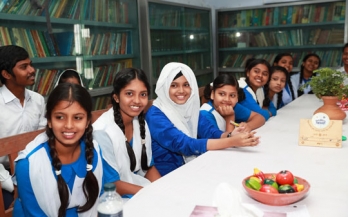Devising strategies to support consumer food choices is a high priority for the food systems and health agenda. Front-of-package labels (FOPL) provide visible nutrition information on packaged foods and have been introduced in 55 countries.
Most front-of-pack labelling (FOPL) systems operate in high-income countries (HICs) on packaged foods purchased in a supermarket setting. To explore the role that FOPL and other types of visual cues could play in supporting consumers’ ability to choose nutritious foods in LMICs, GAIN convened three workshops in 2018-2019.
Through funding from BESTSELLER, GAIN worked in the states of Karnataka and Bihar in India, to improve the nutrition and lives of groups of semi-literate women and children. GAIN equipped women’s Self-Help Groups (SHGs) to produce nutritious food rations.
Animal-source foods (ASF) have long been important components of human diets, providing essential macro- and micronutrients. However, ASF production has increasingly been scrutinised as a driver of negative global environmental change, including climate change.
Large-scale food fortification (LSFF) is a cost-effective intervention that is widely implemented, but there is scope to further increase its potential. To identify gaps and opportunities, we first accessed the Global Fortification Data Exchange (GFDx) to identify countries that could benefit from new fortification programs.
In 2017, a cross-sectional survey, comprised of a household and market in two states (Ebonyi and Sokoto) was conducted using the Fortification Assessment Coverage Toolkit (FACT). The aim of the survey was to provide information on household coverage and consumption of fortifiable and fortified foods among children and women of reproductive age, and availability and quality of fortified foods from markets.
The position paper "Achieving Urban Food and Nutrition Security with the New Urban Agenda", makes recommendations to the Draft New Urban Agenda, emphasising the importance of creating good urban food policies and the key role cities play in this.
There is increasing evidence that improved agrobiodiversity (that is, the diversity of crop and livestock genetic resources – domesticated or wild – which contributes to agriculture and food production) can enhance human nutrition through several pathways.
Malnutrition during adolescence can have lifelong consequences. Adolescents undergo rapid biological and socioemotional changes and set lifelong dietary and related habits. Gender norms can leave girls disproportionately impacted by food insecurity, but many adolescent boys are malnourished as well. Adolescent girls are at risk of dropping out of school, marrying, and becoming pregnant - all of which can harm their nutrition and health as well as that of their offspring.
The period 10-19 years of age is one of accelerated growth both physically and psychosocially. Boys and girls during this rapid growth phase have increased nutritional requirements of both macronutrients (carbohydrate, protein, and fat) and micronutrients. This is due to rapid physical growth and the onset of menses in girls and accelerated muscle and bone mass development in boys.










